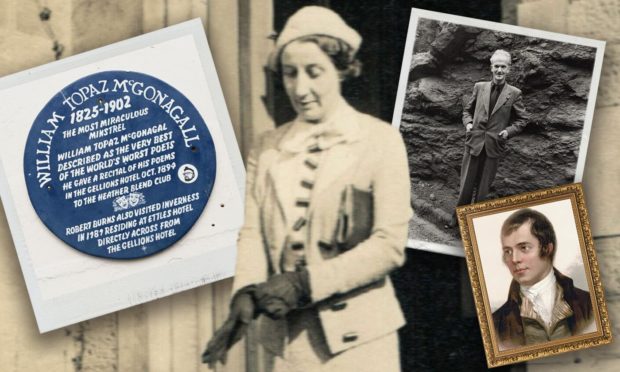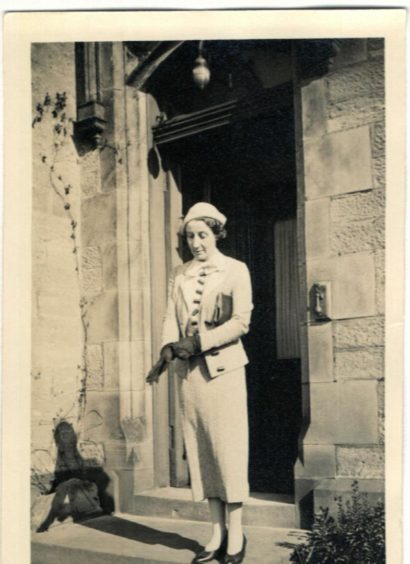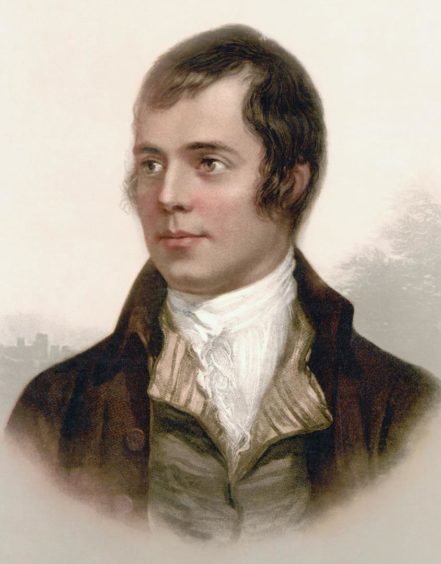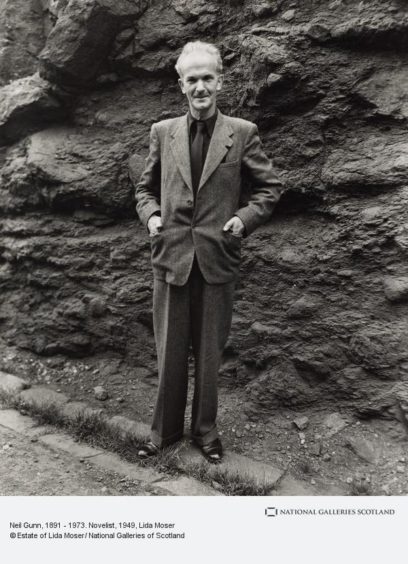A groundswell of support has emerged for the placement of a blue plaque in Inverness to recognise one of its most successful daughters, featured recently in the P&J.
Best-selling author and playwright Elizabeth ‘Beth’ MacKintosh, aka Josephine Tey and Gordon Daviot (1896-1952) had strong connections with the city’s Castle Street, where her family owned a successful fruiterer and various other properties which they rented out.
One of their addresses, no 53 Castle Street, was demolished earlier this year, and is in the process of being rebuilt, complete with the original stone façade.
Might this be the right time and place for a blue plaque?
Tey’s biographer Jennifer Morag Henderson thinks so.
She said: “I think a plaque in her home town would be a lovely way to both recognise and draw attention to her considerable achievements.
“There are several sites associated with Tey and her family in town.
“Castle Street is a central location, which would mean the sign could be seen by many people – and it is not too far from the other writer’s plaques in town, creating a nice little trail that people interested in writing in the Highlands could follow.”
Various organisations award blue plaques, and Jennifer knows of one gentleman from the Richard III Society who, until illness forestalled him, had been looking into an English Heritage plaque, possibly in London, to mark Tey’s impact from her influential 1951 detective novel about Richard III, The Daughter of Time.
National fame
Tey was fêted in London from her heyday in the 1930s until her untimely death in 1952 aged 55.
She had plays on in the West End and Broadway, one of her novels was adapted into a Hitchcock movie, and Hollywood courted her as a scriptwriter.
Jennifer said: “I have always believed in the quality and importance of her writing.
“In terms of critical acclaim, sales and lasting influence, she stands alongside the very best Scottish writers.
“She sometimes had a complex relationship with her Highland identity, but Inverness gave her the time and space she needed to create in her imagination the wonderful worlds of her books and plays.”
Josephine Tey has been placed in the top five crime writers of all time, and is considered ‘the crime writer’s crime writer.’
An obvious body to commission a blue plaque for her would be the Inverness City Heritage Trust (ICHT) which has already placed six such plaques in the city.
So which writers have a blue plaque in the city?
Robert Burns for starters.
His was at the behest of the Inverness Burns Club (IBC) in 2009, the 250th anniversary of Burn’s birth, and is at the site of the former Ettles Hotel on Bridge Street.
The site was demolished in the 1960s to make way for modern concrete structures.
Burns stayed at the hotel towards the end of his Highland tour of August and September 1787.
IBC’s archives record that he came in a post-chaise with coachman, in the company of one William Nicol.
The demands of the trip proved exhausting to the bard.
“After leaving Edinburgh and making stops at Blair Castle and Grantown, the poet and Nicol finally arrived in Inverness on Tuesday September 4 after spending the previous night in the King’s House (now a farm house) at Dulsie Bridge near Nairn and making detours to both Cawdor and Kilravock Castles and to Fort George.
‘Jaded to death with fatigue’
“Burns was meant to meet that evening with Inverness Bailie (later Provost) William Inglis at the latter’s home at Kingsmills House but postponed the meeting with a respectful note of apology saying that he was ‘jaded to death with the fatigue of to-day’s journey – won’t leave Inverness till Thursday morning.’”
The pace picked up again the following day, with Burns’ journal recording the next stage of the tour: ‘Loch Ness – Braes of Ness General’s hut – Falls of Foyers. Urquhart Castle and Strath – Dine at Kilravock – Sup at Mr Inglis’s – Mr Inglis and Mrs Inglis : three young ladies.’
Burns and Nicol spent that night in Inverness at Ettles Hotel, a venue also used as a meeting place by Inverness Town Council.
At the time the hotel would have been run by John Ettles (d 1808).
His nephew, also John, was notable at the time for having made a lot of money managing an estate on Leguan Island, Demerara.
Neil Gunn
Author Neil Gunn also has a blue plaque, at the behest of the Neil Gunn Trust, on the site of the former Customs and Excise House.
Gunn worked there as excise officer between 1921 to 1937.
He was a direct contemporary of Jospehine Tey’s, born in 1891 in Dunbeath, Caithness.
The two would have been well aware of each other.
Unlike Tey’s, Gunn’s writing remained heavily rooted in the Highlands.
And unlike her, he espoused Sottish nationalism and socialism.
London influences
The two authors both spent time in London, and took different influences from the city.
For Tey it was about literature and the theatre, revolving around people like John Geilgud and Laurence Olivier, whereas for Gunn it was all about new political and philosophical ideas.
Both ultimately rejected London to return to their native country, Tey living and writing in Inverness while caring for her widowed father, and Gunn working as a customs and excise officer from 1910.
Gunn remained at excise officer until he was well-established as a writer in 1937.
He married Jessie Dallas Frew in 1921 and the pair settled in Inverness near Gunn’s post at the Glen Mhor distillery before moving to Strathpeffer.
He is also commemorated in Makar’s court, outside the Writers’ Museum in Edinburgh’s Lawnmarket.
The world’s best worst poet
The third author with a blue plaque in Inverness, not by ICHT, is William Topaz McGonagall, described as ‘the very best of the world’s worst poets’ and particularly famous for his doggerel about the Tay Bridge Disaster.
Beautiful railway bridge of the silv’ry Tay
Alas! I am very sorry to say
That ninety lives have been taken away
On the last Sabbath day of 1879
Which will be remember’d for a very long time.
His plaque commemorates a recital he gave of his poems in the Gellions Hotel Oct 1894 to the Heather Blend Club, and is on the wall of the old Gellions Hotel on Bridge, just across the road from where the more illustrious bard had his visit to Ettles Hotel.
Inverness Royal Academy has a blue plaque commemorating its original architect, Alexander Laing, and the Northern Meeting point has a plaque commemorating its place in Highland Games history.
What do members of the public think?
What do Invernessians think about a blue plaque for someone who seems to have been airbrushed from memory, possibly due to her gender, possibly for political reasons, possibly because she didn’t self-promote?
Thespian Claire Cameron wants to see a blue plaque for Tey, and Beth’s achievements recognised in the Inverness Museum too.
She said: “The Florians have presented plays by Gordon Daviot, myself a director of one.”
Reader Teresa Quinn said: “She was such a clever writer, I’ve read all her books. Think my favourite is Brat Farrar.” (This novel was made into a TV series.)
And Jane Beskow says: “I read The Daughter of Time, years ago without knowing who she was. To read of her life and that she went to the IRA is incredible. Such talent!”
Possibility
ICHT’s Alison Tanner said: “I don’t see why we can’t look into the possibility of a plaque for Josephine Tey.
“We currently have a proposal for another plaque for Alexander Ross, and I know that other plaques, not necessarily blue, are proposed in Inverness, eg one for Willie Logan, engineer.
“We’re working with the council to see how we can commemorate other significant people/places in Inverness in a more consistent way.”
Meanwhile, the Richard III Society said they are excited to learn of the prospect of a blue plaque for Tey, praising her contribution to history also.
“The Daughter of Time has served as a switch that turns on a light, or the key that unlocks a door, for many who are interested in Richard III.
“An author of fiction who supplements, complements, and encourages the investigation of fact is deserving of great praise and recognition.
“Josephine Tey has been quietly doing just that for 70 years now.”
See more like this:



